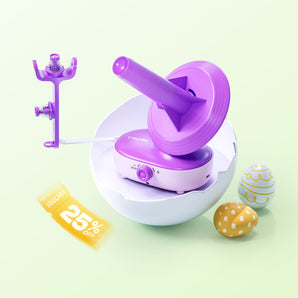KNITTING INCREASE CALCULATOR
Use the calculator below to determine how to increase evenly across your row or round of knitting.
Balanced Increase:
KNITTING DECREASE CALCULATOR
Use the calculator below to determine how to decrease evenly across your row or round of knitting.
Balanced Decrease:
Essential Knitting Calculators for Every Project
Cast-On Calculators
Cast-on calculators help you determine exactly how many stitches to begin with based on your gauge and desired measurements. This is crucial for achieving the correct width in scarves, blankets, or garment pieces.
To use a cast-on calculator:
- Measure your gauge (stitches per inch)
- Enter your desired width
- The calculator provides the number of stitches to cast on
These calculators ensure your project starts with the proper foundation, preventing pieces that end up too narrow or too wide.
Gauge Calculators
Gauge calculators help convert between different yarn weights and needle sizes. They're essential when substituting yarn or adapting patterns.
A typical gauge calculator asks for:
- Your current gauge (stitches and rows per inch)
- Target gauge
- Original stitch count
The calculator then provides the adjusted stitch count needed to maintain proper sizing with your actual gauge.
Yarn Requirement Calculators
Running out of yarn mid-project is every knitter's nightmare. Yarn calculators help estimate how much yarn you'll need based on:
- Project type (sweater, scarf, hat, etc.)
- Measurements
- Yarn weight
- Your gauge
This allows you to purchase sufficient yarn before starting, especially important for discontinued or hand-dyed yarns where matching dye lots later might be impossible.
Increase and Decrease Calculators
Shaping is what transforms flat fabric into three-dimensional garments. Increase and decrease calculators help space these shaping elements evenly throughout your knitting.
These specialized calculators help you:
- Determine where to place increases/decreases
- Calculate even spacing between shaping rows
- Plan gradual or dramatic shaping
The results give you row-by-row instructions for perfectly executed shaping that looks professional and fits well.
Ready to organize your yarn collection for better project planning? Explore Caydo's knitting and crocheting supplies for storage solutions and quality tools to complement your knitting calculator usage.
Using a Knitting Calculator for Gauge and Sizing
How to Measure and Calculate Your Knitting Gauge
Accurate gauge measurement is the foundation of successful calculator use. To measure your gauge:
- Knit a sample swatch at least 4" × 4"
- Block the swatch as you would the finished project
- Place a ruler on the swatch and count stitches across 4 inches
- Divide by 4 to find stitches per inch
- Repeat for rows to find rows per inch
Enter these measurements into your gauge calculator for accurate project planning.
Converting Patterns to Different Yarn Weights
When substituting yarns, calculating the right adjustments is crucial. A yarn weight conversion calculator helps by:
- Comparing the gauge of your chosen yarn to the pattern's recommended yarn
- Recalculating stitch counts based on the difference
- Suggesting needle size adjustments to achieve the right fabric
This allows you to use your preferred yarn while maintaining the intended dimensions of the pattern.
Adjusting Patterns for Custom Measurements
Custom sizing calculators help tailor patterns to fit specific body measurements. These calculators:
- Compare standard pattern measurements to your desired measurements
- Calculate necessary adjustments to stitch counts and row counts
- Provide modified instructions for each pattern section
This personalization ensures comfortable, flattering garments that actually fit the wearer.
Curious about yarn weights and how they affect your calculations? Check out Caydo's informative article on worsted weight yarn to understand how different weights influence your knitting calculator results.
Increase and Decrease Knitting Calculators
Calculating Evenly Spaced Increases for Shaping
Evenly spaced increases create smooth, professional-looking shaping. An increase calculator helps you determine:
- How many stitches to increase overall
- How many rows to spread the increases across
- Exactly which stitches to increase on each row
For example, if you need to increase 20 stitches over 10 rows, the calculator will tell you to increase 2 stitches on each row, with specific placement instructions.
Using Decrease Calculators for Sleeves and Necklines
Proper decrease in sleeves and necklines create comfortable, well-fitting garments. Decrease calculators help by:
- Determining decrease rate based on desired shaping
- Calculating intervals between decrease rows
-
Suggesting decrease methods for different effects
This precise approach prevents awkward bunching or tight areas in your finished piece.
Calculating Increases for Circular Knitting Projects
Circular knitting presents unique calculation challenges, especially when increasing for areas like yokes or raglan sleeves. These specialized calculators:
- Account for the continuous nature of circular knitting
- Calculate increases based on stitch multiples around the circle
- Provide placement instructions to maintain symmetry
The result is smooth, even shaping that follows the garment's natural lines.
Looking for tools to enhance your circular knitting? Explore Caydo's I-cord knitting machine collection for creating perfect I-cords to complement your circular knitting projects.
DIY Knitting Calculations
Basic Math Behind Knitting Calculations
Understanding the basic formulas helps you double-check calculator results:
- Cast-on count = gauge (stitches per inch) × desired width in inches
- Row count = gauge (rows per inch) × desired length in inches
- Increases/decreases per row = total stitches to change ÷ number of shaping rows
These simple equations form the foundation of most knitting calculations.
Creating Your Own Spreadsheet Calculators
For personalized calculation tools, creating spreadsheets allows you to:
- Input your common gauge measurements
- Set up formulas for frequent calculations
- Save project details for future reference
-
Customize to your specific knitting style
Basic spreadsheet skills are all you need to create these personalized calculators.
Understanding Ratios and Proportions in Knitting
Many knitting calculations involve proportional thinking:
- Body-to-sleeve width ratios
- Armhole-to-sleeve cap proportions
- Foot-to-leg relationships in socks
Understanding these relationships helps you evaluate calculator results and make intuitive adjustments when needed.
Are you a beginner looking to tackle machine knitting with calculated precision? Check out Caydo's guide to the best knitting machine for beginners to complement your hand knitting journey.
Troubleshooting with Knitting Calculators
When Calculator Results Don't Match Your Knitting
If your knitting doesn't match calculator predictions, check these common issues:
- Inaccurate gauge measurement
- Changes in tension as you knit
- Calculator input errors
- Misinterpreted pattern instructions
Often, rechecking your gauge on a larger swatch resolves discrepancies.
Adjusting for Personal Knitting Tension
Personal knitting tension affects calculations. If you know your tension tends to change:
- For looser knitters: Calculate with a slightly tighter gauge
- For tighter knitters: Calculate with a slightly looser gauge
- For uneven knitters: Take multiple gauge measurements and average them
These adjustments personalize calculator results to your unique knitting style.
Fixing Calculation Errors Mid-Project
If you discover calculation errors partway through a project:
- Determine the exact problem (too many/few stitches, incorrect proportions)
- Use calculators to determine correction options
- Decide whether to continue with adjustments or restart
- Document the fix for future reference
Sometimes minor calculation errors can be incorporated into the design as intentional elements!
Level Up: Transform Your Knitting Today!
Ready to revolutionize your knitting after discovering calculator tools? These digital assistants transform uncertain crafting into confident creation while producing perfectly fitted garments.
For knitters serious about precision, pair your favorite knitting calculator with Caydo's premium knitting supplies.
From their versatile knitting needles to organized storage solutions, Caydo's quality tools complement your calculated approach and help bring your precisely planned projects to life with professional results.
Frequently Asked Questions
How do you calculate stitch count?
To calculate stitch count, multiply your stitches per inch (from your gauge swatch) by the desired width in inches of your project. For example, if your gauge is 5 stitches per inch and you want a 10-inch wide scarf, you'll need to cast on 50 stitches. Always make a gauge swatch before starting your project to ensure accurate measurements.
What is the best way to cast on stitches in knitting?
The long-tail cast-on is widely considered the best all-purpose method because it creates a flexible yet sturdy edge that works well for most projects. For beginners, the knitted cast-on might be easier to learn as it uses the same movements as the basic knit stitch. Choose your cast-on method based on your project's needs—ribbed edges benefit from stretchier methods while firm edges work better with cable cast-on.
How do you calculate yarn for knitting?
Calculate yarn requirements by multiplying the project's total square inches by the yards of yarn needed per square inch according to your gauge. Most knitting calculators can perform this calculation automatically when you input your gauge, project dimensions, and yarn information. Always purchase slightly more yarn than calculated to account for gauge variations and to avoid running out.
How much yarn to knit a scarf?
A typical adult scarf measuring 6 inches wide by 60 inches long requires approximately 300-500 yards of worsted weight yarn. The exact amount varies based on your gauge, the complexity of the stitch pattern, and the yarn weight you choose. Always purchase an extra skein beyond your calculation to avoid running out mid-project.
Related Articles:








![[Must-have] Knitting Yarn and Wire Set - Caydo](http://www.caydo.com/cdn/shop/files/3_4c349a4b-7e4d-4fa8-b6df-6561cf08410c.jpg?v=1731059827&width=298)
![[Must-have] Knitting Yarn and Wire Set - Caydo](http://www.caydo.com/cdn/shop/files/1_c1a8ec5f-79f5-4c02-b655-aaba689678cf.jpg?v=1731060862&width=298)










